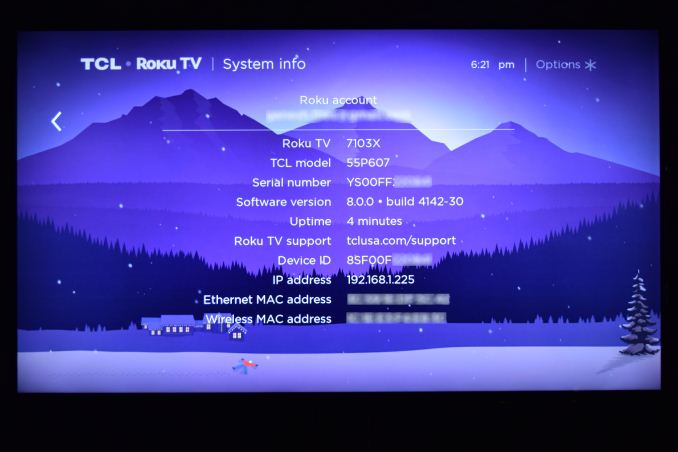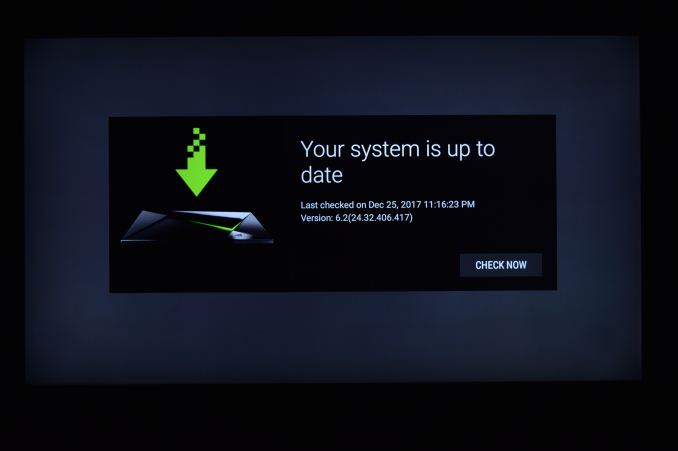A Budget Home Theater & PC Setup: 4K, HDR, UHD Blu-ray, and More
by Ganesh T S on December 26, 2017 8:30 AM ESTEvaluating Display Sources: HTPCs & CE Devices
Home Theater PCs used to be bulky versatile machines that had to support built-in TV tuners, a number of hard disks, as well as optical drives. However, the rising popularity of network TV tuners, network-attached storage (NAS) devices, and OTT streaming have resulted in the a transformation of the functionality that people expect from HTPCs. Simply put, a modern-day HTPC needs to be a flexible and versatile media player capable of handling a multitude of codecs and DRM requirements. The latter is not restricted to the handling of the encoded video. The display output also needs to be secure, while providing enough bandwidth and features to take full advantage of the capabilities of the downstream devices in the setup.
The average consumer often finds the 'it just works' nature of consumer electronic (CE) equipment such as the Roku streamers, game consoles, and standalone Blu-ray players to be attractive. However, for power users, the flexibility of HTPCs (such as the ability to support arcane subtitle formats or specific container features such as MKV chapters, or, even serve as a gaming machine) is simply too much to give up. Certain CE devices such as the NVIDIA SHIELD Android TV STB attempt to offer the best of both worlds. However, they are still closed platforms, and often do not have enough horsepower to fall back upon software decode for unsupported codecs.
Despite my predilection for HTPCs, I wanted to bring out the pros and cons of other closed solutions. Towards this, the evaluation of various options for media playback / display sources addresses the following aspects:
- HDR Support
- OTT Streaming (YouTube and Netflix)
- Local Media Playback (via USB)
- UHD Blu-ray Playback with HDR
The first candidate is the TCL 55P607's built-in Roku platform. Our tests were processed with the TV connected to the network using its wired 10 / 100 Mbps interface and Wi-Fi disabled. Firmware version 8.0.0 4142-30 was used.
The second solution in our evaluation set is one of the most popular Android TV STBs in the market - the NVIDIA SHIELD Android TV (SATV). Despite having launched back in 2015, the combination of high-end hardware and regular firmware updates have kept it at the top of the media player / Android TV STB market. Our tests were processed with the SHEILD connected to the network using its wired 1 Gbps interface and Wi-Fi disabled. Firmware version 6.2 was used.
The use of a RF remote / controller, combined with IP control using a smartphone app, mean that the SHIELD can be safely tucked away out of sight in a home theater setup.
Moving on to the HTPC front, we have three different PCs, with configurations and driver versions listed in the table below.
| Compact Home Theater PC Candidates - 2017 | |||
| PC | Zotac ZBOX MAGNUS EN1080K | ASRock Beebox-S 7200U | Intel NUC7i7BNHX1 |
| CPU | Intel Core i7-7700 | Intel Core i5-7200U | Intel Core i7-7567U |
| GPU | NVIDIA GTX 1080 (8GB GDDR5X) | Intel HD Graphics 620 | Intel Iris Graphics 650 |
| RAM | Corsair Vengeance 2x16GB DDR4-2667 SODIMM | Micron 16ATF1G64HZ 2x8GB DDR4-2133 SODIMM | Crucial Ballistix Sport LT 2x16GB DDR4-2400 SODIMM |
| Storage | Toshiba OCZ RD400 (512GB) | Kingston SSD Now V+ SNV325S2 (128GB) | Samsung SSD 840 EVO (500GB) + Intel Optane (16GB) |
| BIOS | 2K170814 | 1.73 | BNKBL357.86A.0054 |
| GPU Driver | 388.31 | 4877+ (beta) | 4877+ (beta) |
| Specifications | Zotac ZBOX MAGNUS EN1080K Specifications | ASRock Beebox-S 7200U Specifications | Intel NUC7i7BNHX1 Specifications |
| Pricing (NOT as configured) | USD 2000 (with 120GB SSD, 1TB HDD, 8GB RAM, and Windows 10) | USD 349 (Barebones) | USD 506 (Barebones) |
Note that we are using a beta driver from Intel that will be released to the public in January 2018. The reason behind the use of this driver will be apparent in our UHD Blu-ray Playback section.
Windows 10 Fall Creators Update was used as the OS for all the tests done using the above PCs. This version is critical for cutting-edge HTPC functionality, as it brings HDR desktop and media payback support into the stable release channel.













191 Comments
View All Comments
Golgatha777 - Tuesday, December 26, 2017 - link
It doesn't even make financial sense to try and do 4k Blu-ray on PC. The optical drive is $117 and the playback software, PowerDVD 17 is $40 currently. Add to this the requirement for specific motherboards and CPUs for the DRM chain, and you've more than paid for an XBox One S.Not to mention from my anecdotal experiences during the Bluray days, the software will be buggy as hell, the audio will be a pain in the ass to configure correctly, and you'll need to update the software (in this case PowerDVD) to the newest version down the road to keep up with the DRM key refreshes.
I built a HTPC years ago, and it's only still useful because I also use it to game on, and because of software that strips DRM off my discs. Now that commercial playback software must support Cinavia, it's useless to me as well for playing back ripped ISO images and media files; so I turn to open source programs and will keep my old hardware that ignores Cinavia, etc. for playback. For streaming and 4k discs, and XBox One S is much more cost effective, and the playback software will get updated for free going forward (support for new DRM keys, Dolby Vision, Dolby Atmos, etc.).
Golgatha777 - Tuesday, December 26, 2017 - link
Forgot the $26 for a SATA breakout drive enclosure for the 5.25in optical drive.edzieba - Tuesday, December 26, 2017 - link
For regular BD playback, by far the most painless experience is to just use AnyDVDHD and play the movie file directly off of the disc. No mucking about with menus (and waiting for a Java VM to load up just to RUN the menus!), no dealing with the steaming pile of garbage that is PowerDVD, no worrying about having to have an obtuse HDCP compatible chain, etc.Recent developments have shown HDCP 2 is on the way to being broken in a similar way, so soon the only practical requirements may be a BDXL capable drive and a HDR capable monitor/TV.
Fujikoma - Thursday, December 28, 2017 - link
I rip everything to an NAS and strip the Cinavia out of it. It also saves me the hassle of getting off my lazy butt and I can just stream anywhere in my house without a problem. My 4k BD drives cost me less than $70 (LG) and they both work fine for ripping (1950X TR with NVidia 1080). I can use my XBoneS for the odd video files (format, audio and sub options) I have and the Roku (boxes and the t.v. built-ins) work just fine for my h265 MP4s. I think you're right that the XBone platform would be a better option for 4k at this point. I'd use a 4k dedicated player for family, if no one games because it's less complicated. With family, fewer remotes and components has been the way to go. That's why I keep the amps and pre-amp setup in my computer room.The article, itself, doesn't really make any sense because there's too much skimping on the home theatre. Just easier to start with a good t.v. and audio setup with front speakers only, then add in the extra bells and whistles later. The list doesn't even contain a sub... which means a decent sound bar would be viable option to ceiling speakers as the surround setup isn't even in the cost breakdown.
rapster - Sunday, December 31, 2017 - link
How do you strip out Cinavia? Last I heard there still wasn’t a viable solution and would be very glad to hear that the situation has changed.Fujikoma - Sunday, January 7, 2018 - link
I'm not going to list the software, as it already had a run-in with the U.S. govt. and I don't feel like causing myself more hassle again even though I have a legal right to rip my own BD/DVD collection. Considering I (as does everyone in the U.S.) pay a 'fine' to the recording industry every time I purchase recordable/storage media for potential pirating/format change of stuff I own, my attitude towards it is even more jaded. Needless to say, the software was worth the money.Aikouka - Wednesday, December 27, 2017 - link
I wouldn't just flat-out recommend the Xbox One to anyone as a UHD BR player. The Xbox One's biggest problem is that it's far too noisy when playing UHD Blu-rays (disc noise), and it's quite easy to hear during quieter parts of a movie. I went that route to start with, and it only took me one movie to start researching alternatives. Unfortunately, most alternatives have issues too. Sony's player is arguably the one that has the least amount of awkward teething issues, but it'll never support Dolby Vision. (TCL's P605/P607 supports Dolby Vision.) LG was supposed to add it, but they pulled the update. I've also heard complaints of noise from other players. The only player that seems to get decent praise is Oppo's 203, but it's also over twice as expensive as the others (~$500).edlee - Thursday, December 28, 2017 - link
I understand the superiority of Dolby Vision, but the fact that its not widely supported in the tv market, only LG, roku tv, and vizio support the feature. All the support is going to the forthcoming HDR10+, i know its difficult to review right now, but its an open standard and royalty free. You will see support for it from more tv manufacturers as well. It has streaming support from Amazon on over 100 titles, and support is mostly coming from Netflix in the future.Reflex - Thursday, December 28, 2017 - link
And honestly until you get to 80" or higher projector style setups DV is unlikely to make a noticeable difference in image quality. DV is a nice to have, but not at all mandatory for a first class experience, at least not yet.HStewart - Friday, December 29, 2017 - link
I actually have Xbox One S and primary used it for UHD Blu-rays. There is difference in having it on PC then on Xbox - because you can also used it as 4K Monitor which is good fro graphics programs.I would agree for low cost it best to go for Xbox One S ( or X ).
I would think with this Pioneer drive - you should be able to get HULU in 4k on PC - but even with the Xbox you will need 13 megabit Internet connection to run 4k HULU.